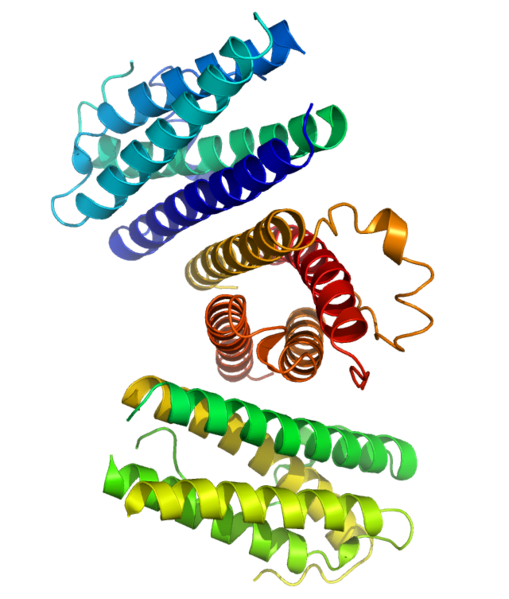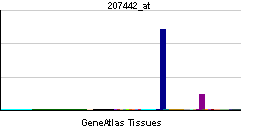Granulocyte colony stimulating factor
 From Wikidoc - Reading time: 7 min
From Wikidoc - Reading time: 7 min
| Colony stimulating factor 3 (granulocyte) | |||||||||||
|---|---|---|---|---|---|---|---|---|---|---|---|
 | |||||||||||
| Identifiers | |||||||||||
| Symbols | CSF3 ; G-CSF; GCSF; MGC45931 | ||||||||||
| External IDs | Template:OMIM5 Template:MGI HomoloGene: 7677 | ||||||||||
| |||||||||||
| RNA expression pattern | |||||||||||
 | |||||||||||
| More reference expression data | |||||||||||
| Orthologs | |||||||||||
| Template:GNF Ortholog box | |||||||||||
| Species | Human | Mouse | |||||||||
| Entrez | n/a | n/a | |||||||||
| Ensembl | n/a | n/a | |||||||||
| UniProt | n/a | n/a | |||||||||
| RefSeq (mRNA) | n/a | n/a | |||||||||
| RefSeq (protein) | n/a | n/a | |||||||||
| Location (UCSC) | n/a | n/a | |||||||||
| PubMed search | n/a | n/a | |||||||||
Editor-In-Chief: C. Michael Gibson, M.S., M.D. [1]
Overview[edit | edit source]
Granulocyte Colony-Stimulating Factor (G-CSF or GCSF) is a colony-stimulating factor hormone. It is a glycoprotein, growth factor or cytokine produced by a number of different tissues to stimulate the bone marrow to produce granulocytes and stem cells. G-CSF then stimulates the bone marrow to pulse them out of the marrow into the blood. It also stimulates the survival, proliferation, differentiation, and function of neutrophil precursors and mature neutrophils.
G-CSF is also known as Colony-Stimulating Factor 3 (CSF 3).
Biological function[edit | edit source]
G-CSF is produced by endothelium, macrophages, and a number of other immune cells. The natural human glycoprotein exists in two forms, a 174- and 180-amino-acid-long protein of molecular weight 19,600 grams per mole. The more-abundant and more-active 174-amino acid form has been used in the development of pharmaceutical products by recombinant DNA (rDNA) technology.
Mouse granulocyte colony-stimulating factor (G-CSF) was first recognised and purified in Australia in 1983, and the human form was cloned by groups from Japan and the United States in 1986.
The G-CSF-receptor is present on precursor cells in the bone marrow, and, in response to stimulation by G-CSF, initiates proliferation and differentiation into mature granulocytes.
Genetics[edit | edit source]
The gene for G-CSF is located on chromosome 17, locus q11.2-q12. Nagata et al. found that the GCSF gene has 4 introns, and that 2 different polypeptides are synthesized from the same gene by differential splicing of mRNA.[1]
The 2 polypeptides differ by the presence or absence of 3 amino acids. Expression studies indicate that both have authentic GCSF activity.
It is thought that stability of the G-CSF mRNA is regulated by an RNA element called the G-CSF factor stem-loop destabilising element.
Therapeutic use[edit | edit source]
G-CSF stimulates the production of white blood cells (WBC). In oncology and hematology, a recombinant form of G-CSF is used with certain cancer patients to accelerate recovery from neutropenia after chemotherapy, allowing higher-intensity treatment regimens. Chemotherapy can cause myelosuppression and unacceptably low levels of white blood cells, making patients prone to infections and sepsis. However, in a Washington University School of Medicine study using mice, G-CSF is shown to lessen the density of bone tissue even while it increases the WBC count; if this is found to occur in human cases it would necessitate increased consumption of calcium and vitamins A and D, and maybe drug therapy.
G-CSF is also used to increase the number of hematopoietic stem cells in the blood of the donor before collection by leukapheresis for use in hematopoietic stem cell transplantation. It may also be given to the receiver, to compensate for conditioning regimens.
Itescu planned in 2004 to use G-CSF to treat heart degeneration by injecting it into the blood-stream, plus SDF (stromal cell-derived factor) directly to the heart.[2]
The recombinant human G-CSF synthesised in an E. coli expression system is called filgrastim. The structure of filgrastim differs slightly from the structure of the natural glycoprotein. Most published studies have used filgrastim. Filgrastim (Neupogen) and PEG-filgrastim (Neulasta) are two commercially-available forms of rhG-CSF (recombinant human G-CSF). The PEG (polyethylene glycol) form has a much longer half-life, reducing the necessity of daily injections.
Another form of recombinant human G-CSF called lenograstim is synthesised in Chinese Hamster Ovary cells (CHO cells). As this is a mammalian cell expression system, lenograstim is indistinguishable from the 174-amino acid natural human G-CSF. No clinical or therapeutic consequences of the differences between filgrastim and lenograstim have yet been identified, but there are no formal comparative studies.
See also[edit | edit source]
References[edit | edit source]
- ↑ Nagata S, Tsuchiya M, Asano S, Kaziro Y, Yamazaki T, Yamamoto O, Hirata Y, Kubota N, Oheda M, Nomura H, et al. Molecular cloning and expression of cDNA for human granulocyte colony-stimulating factor. Nature 1986;319:415-8. PMID 3484805.
- ↑ Elizabeth Finkel, Stem Cells, 2005, ABC Books, ISBN 0 7333 1248 9
Further reading[edit | edit source]
- Duarte RF, Franf DA (2003). "The synergy between stem cell factor (SCF) and granulocyte colony-stimulating factor (G-CSF): molecular basis and clinical relevance". Leuk. Lymphoma. 43 (6): 1179–87. PMID 12152985.
- Mroczko B, Szmitkowski M (2005). "Hematopoietic cytokines as tumor markers". Clin. Chem. Lab. Med. 42 (12): 1347–54. doi:10.1515/CCLM.2004.253. PMID 15576295.
- Sallerfors B, Olofsson T (1993). "Granulocyte-macrophage colony-stimulating factor (GM-CSF) and granulocyte colony-stimulating factor (G-CSF) secretion by adherent monocytes measured by quantitative immunoassays". Eur. J. Haematol. 49 (4): 199–207. PMID 1281454.
- Zink T, Ross A, Ambrosius D; et al. (1993). "Secondary structure of human granulocyte colony-stimulating factor derived from NMR spectroscopy". FEBS Lett. 314 (3): 435–9. PMID 1281794.
- Kubota N, Orita T, Hattori K; et al. (1990). "Structural characterization of natural and recombinant human granulocyte colony-stimulating factors". J. Biochem. 107 (3): 486–92. PMID 1692828.
- Souza LM, Boone TC, Gabrilove J; et al. (1986). "Recombinant human granulocyte colony-stimulating factor: effects on normal and leukemic myeloid cells". Science. 232 (4746): 61–5. doi:10.1126/science.2420009. PMID 2420009.
- Nagata S, Tsuchiya M, Asano S; et al. (1986). "The chromosomal gene structure and two mRNAs for human granulocyte colony-stimulating factor". EMBO J. 5 (3): 575–81. PMID 2423327.
- Simmers RN, Smith J, Shannon MF; et al. (1988). "Localization of the human G-CSF gene to the region of a breakpoint in the translocation typical of acute promyelocytic leukemia". Hum. Genet. 78 (2): 134–6. doi:10.1007/BF00278182. PMID 2448221.
- Tweardy DJ, Cannizzaro LA, Palumbo AP; et al. (1988). "Molecular cloning and characterization of a cDNA for human granulocyte colony-stimulating factor (G-CSF) from a glioblastoma multiforme cell line and localization of the G-CSF gene to chromosome band 17q21". Oncogene Res. 1 (3): 209–20. PMID 2453015.
- Tsuchiya M, Nomura H, Asano S; et al. (1987). "Characterization of recombinant human granulocyte-colony-stimulating factor produced in mouse cells". EMBO J. 6 (3): 611–6. PMID 3034599.
- Nagata S, Tsuchiya M, Asano S; et al. (1986). "Molecular cloning and expression of cDNA for human granulocyte colony-stimulating factor". Nature. 319 (6052): 415–8. doi:10.1038/319415a0. PMID 3484805.
- Devlin JJ, Devlin PE, Myambo K; et al. (1987). "Expression of granulocyte colony-stimulating factor by human cell lines". J. Leukoc. Biol. 41 (4): 302–6. PMID 3494801.
- Kanda N, Fukushige S, Murotsu T; et al. (1987). "Human gene coding for granulocyte-colony stimulating factor is assigned to the q21-q22 region of chromosome 17". Somat. Cell Mol. Genet. 13 (6): 679–84. doi:10.1007/BF01534488. PMID 3499671.
- Le Beau MM, Lemons RS, Carrino JJ; et al. (1988). "Chromosomal localization of the human G-CSF gene to 17q11 proximal to the breakpoint of the t(15;17) in acute promyelocytic leukemia". Leukemia. 1 (12): 795–9. PMID 3501046.
- Zink T, Ross A, Lüers K; et al. (1994). "Structure and dynamics of the human granulocyte colony-stimulating factor determined by NMR spectroscopy. Loop mobility in a four-helix-bundle protein". Biochemistry. 33 (28): 8453–63. doi:10.1021/bi00194a009. PMID 7518249.
- Corcione A, Baldi L, Zupo S; et al. (1994). "Spontaneous production of granulocyte colony-stimulating factor in vitro by human B-lineage lymphocytes is a distinctive marker of germinal center cells". J. Immunol. 153 (7): 2868–77. PMID 7522243.
- Watari K, Ozawa K, Tajika K; et al. (1994). "Production of human granulocyte colony stimulating factor by various kinds of stromal cells in vitro detected by enzyme immunoassay and in situ hybridization". Stem Cells. 12 (4): 416–23. PMID 7524894.
- Hill CP, Osslund TD, Eisenberg D (1993). "The structure of granulocyte-colony-stimulating factor and its relationship to other growth factors". Proc. Natl. Acad. Sci. U.S.A. 90 (11): 5167–71. doi:10.1073/pnas.90.11.5167. PMID 7685117.
- Haniu M, Horan T, Arakawa T; et al. (1996). "Extracellular domain of granulocyte-colony stimulating factor receptor. Interaction with its ligand and identification of a domain in close proximity of ligand-binding region". Arch. Biochem. Biophys. 324 (2): 344–56. doi:10.1006/abbi.1995.0047. PMID 8554326.
- McCracken S, Layton JE, Shorter SC; et al. (1996). "Expression of granulocyte-colony stimulating factor and its receptor is regulated during the development of the human placenta". J. Endocrinol. 149 (2): 249–58. doi:10.1677/joe.0.1490249. PMID 8708536.
External links[edit | edit source]
- Granulocyte+Colony-Stimulating+Factor at the US National Library of Medicine Medical Subject Headings (MeSH)
- GCSF at The GDB Human Genome Database
 KSF
KSF